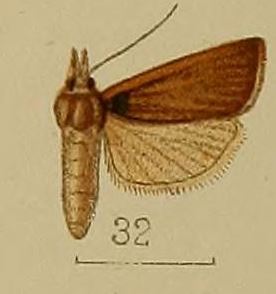
Crambinae is a large subfamily of the lepidopteran family Crambidae, the crambid snout moths. It currently includes over 1,800 species worldwide. The larvae are root feeders or stem borers, mostly on grasses. A few species are pests of sod grasses, maize, sugar cane, rice, and other Poaceae. The monophyly of this group is supported by the structure of the tympanal organs and the phallus attached medially to the juxta.

Galtara is a genus of tiger moths in the family Erebidae. The genus was erected by Francis Walker in 1863.

Cirrhochrista is a genus of moths of the family Crambidae described by Julius Lederer in 1863.

Pseudocatharylla is a genus of moths of the family Crambidae.

Semiothisa is a genus of moths in the family Geometridae. It was erected by Jacob Hübner in 1818.
Caffrocrambus decolorellus is a moth in the family Crambidae. It was described by Francis Walker in 1863. It is found in South Africa.
Pseudocatharylla allecto is a moth in the family Crambidae. It was described by Graziano Bassi in 1999. It is found in the Democratic Republic of the Congo.
Pseudocatharylla asteria is a moth in the family Crambidae. It was described by Graziano Bassi in 1999. It is found in Malawi.
Pseudocatharylla calypso is a moth in the family Crambidae. It was described by Graziano Bassi in 1999. It is found in Botswana.
Pseudocatharylla megera is a moth in the family Crambidae. It was described by Graziano Bassi in 1999. It is found in the Democratic Republic of the Congo.
Pseudocatharylla shafferi is a moth in the family Crambidae. It was described by Graziano Bassi in 1999. It is found in the Democratic Republic of the Congo and Tanzania.
Pseudocatharylla tisiphone is a moth in the family Crambidae. It was described by Graziano Bassi in 1999. It is found in Cameroon, the Republic of the Congo and the Democratic Republic of the Congo.
Pseudocatharylla argenticilia is a moth in the family Crambidae. It was described by George Hampson in 1919. It is found in Cameroon, the Central African Republic, Ghana, Guinea, Nigeria and Sierra Leone.
Pseudocatharylla peralbellus is a moth in the family Crambidae. It was described by George Hampson in 1919. It is found in Ghana and Nigeria.
Pseudocatharylla inclaralis is a moth in the family Crambidae. It was described by Francis Walker in 1863. It is found in China and Japan.
Pseudocatharylla infixellus is a moth in the family Crambidae. It was described by Francis Walker in 1863. It is found in China, Japan and Taiwan.
Pseudocatharylla faduguella is a moth in the family Crambidae. It was described by Rob T.A. Schouten in 1994. It is found in Sierra Leone.
Pseudocatharylla photoleuca is a moth in the family Crambidae. It was described by Oswald Bertram Lower in 1903. It is found in Australia, where it has been recorded from Queensland.
Scirpophaga occidentella is a moth in the family Crambidae. It was described by Francis Walker in 1863. It is found in Angola, the Democratic Republic of the Congo, Ivory Coast, Madagascar, Malawi, Mozambique, Nigeria, Senegal, Sierra Leone, South Africa and Tanzania.



